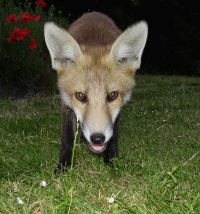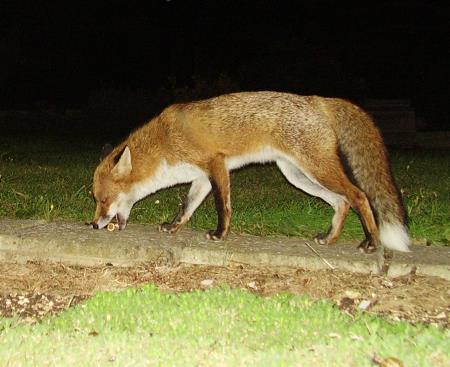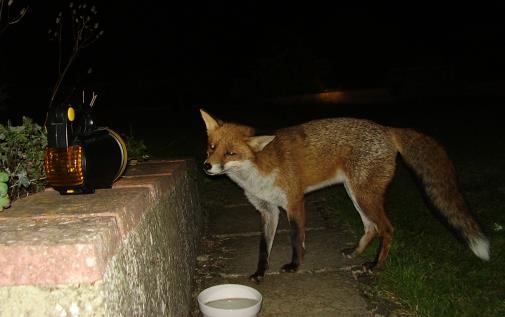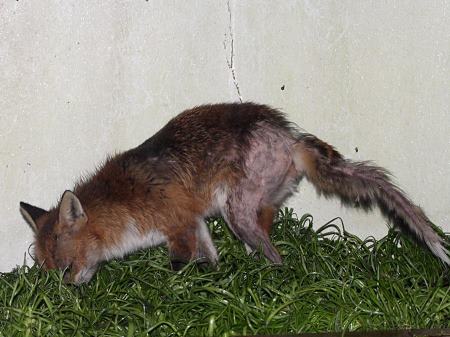 Fox Watch! FAQs | |
Some basic fox FAQs gleaned from my experiences of fox watching
What time do foxes visit?
The most common time is early to mid evening. We first started to see the foxes at night (several cubs at a time would appear at the rear of the garden), but the most common time seems to be early to mid evening. They do visit later (evidence of food disappearing is proof of that). We've also seen them early in the morning, and when it's sunny they do show up in the middle of the day.
How do I encourage them to visit my garden?
If you want to encourage foxes to visit, small amounts of food left at a regular time will get them to add you to their tour of the neighbourhood. Keep out of the way until they are used to you. They are very shy and easily scared off or discouraged.
|
What food do they like?
They like sultanas, tinned dog food, scraps of meat, eggs (a real favourite), and Markies. They don't like apples. The photograph shows a fox picking up a Markie. |
 |
How much should I feed them?
Keep the feeding light. Foxes are hunters and scavengers and during most of the year there is plenty of food available for them. Your feeding should be a small supplement to their diet. It shouldn't replace their natural activity. Foxes will eat grubs, insects, worms, frogs and small rodents and rabbits. They will also eat small birds, and birds' eggs. On a couple of occasions our local foxes have climbed the trees bordering the garden in search of eggs.
Can I touch them?
The simple answer is No!. And the complicated answer is No!.
Several reasons I say that, but the main one is that these are not domestic animals and maintaining a healthy respect for each other is a sensible policy for both human and fox. Foxes have very large and very sharp teeth. They are also nervous. As any dog owner will know, a nervous dog might try and nip, especially if it is surprised. A fox "nip" won't be very pleasant at all, though the risk of being bitten is extremely small. In several years of close observation I've never 'petted' any of the foxes, although I have let the more curious sniff at me, and occasionally felt a tug on clothing. Also, although the cubs are cute and curious, it does them no favours to get a human scent on them. So, it's a case of look but don't touch.
They always run away from me. How do I get closer?
Foxes are rightly nervous of humans. Generally you have to let them approach you. If you want to get closer, be patient. Leave small tid-bits of food to get them familiar with the territory (and don't try and watch except from a window). When they are more regular visitors, stay outside at a good distance from where the food is.
With luck and patience they'll tolerate your presence while they feed. In time, position yourself closer to them. They may approach you (more tid-bits are a good inducement). If they do, move slowly and don't make sudden or loud noises or gestures. Soothing coos and clicks are fine. If you're lucky, they'll be tolerant. With the dog fox in the early photos on this site I could pretty much do what I wanted in the garden... walk straight up to him, follow him with the camera. One of the cubs was also as tolerant. But the other cubs and the vixen simply scoot away when they spot me (and that's after several months). Even quite bold foxes will back off at sudden movement, so patience is absolutely the key.
|
Can I use a torch (flashlight)?
Yes. Lights don't seem to bother them at all. They are fine with the flash on my camera (even close up). In this photo, the fox has come up to investigate the light from the torch.
|
 |
Do they carry diseases?
In the U.K. we are fortunate that foxes don't carry rabies. But that isn't the case in other countries. But as with any wild creature they may carry ticks, fleas, worms. Another reason for the 'no touching' rule.
Why does my fox look skinny and ill?
Foxes lose their winter coat in spring, and they tend to look somewhat more grey in colour, with a patchy pelt. The young cubs also chew on the parents' tails so this can look in very poor shape indeed. Other causes may be fleas or ticks, or in the worst cases, mange.
|
What is mange?
Mange is a serious mite infestation that can kill a fox in a short period. The NFWS site has good information and is able to offer a homeopathic treatment. Foxes can also be treated with ivermectin which is very effective but needs close supervision to ensure only the infected fox takes (and eats) the treatment. If you are concerned, contact a local wildlife rescue centre.
The photo on the right shows a moderate case of mange (successfully treated over a period of weeks).
|
 |
How do I stop foxes digging holes in my garden?
Not easy. There are two main types of digging. Foxes will often try and dig an entrance to a den (earth) under sheds, and adults are capable of movement large amounts of soil and rubble. More commonly you may find small holes and gouges in flower beds and lawns, especially in early summer. This is predominantly cub behaviour and does stop after a while. By and large a combination of pea sticks and link-stakes has successfully protected the plants in our garden, but foxes can cause light damage to gardens.
Foxes also dig lots of very small holes. This is how they cache (hide) food, for later retrieval. Generally these are quite hard to spot (unless you have a perfect lawn), as they take great care to repair the ground with their nose. If you find an egg-shell buried in your lawn (or in a plant pot) you can be certain that a fox has been visiting.
I'm not sure if we have a fox or not. How can I tell?
Foxes leave various traces of their activity. Signs of digging are one (see above). They also leave a fairly musky smell in their territory. It's quite distinctive, but I wouldn't describe it as unpleasant (not that you'd choose it as a perfume either). They leave smallish dark stools (a couple of inches in length), and sometimes use these to mark territory that is important to them.
Other sources of information
|
|
[Fox Blog] | |




 all text and images copyright Paul Cecil, 2005
all text and images copyright Paul Cecil, 2005